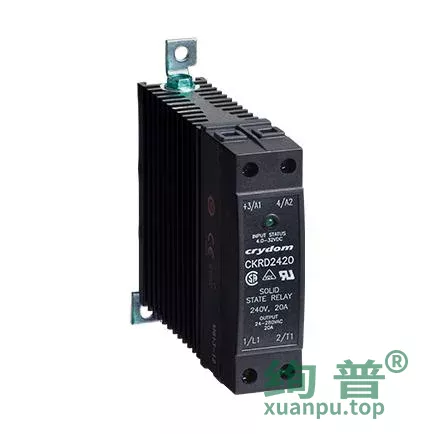Welcome to Shanghai Xuanpu Electronic Technology Co., Ltd!
- Site Map
- Contact Us
- Follow WeChat

-
 简体中文
简体中文
Welcome to Shanghai Xuanpu Electronic Technology Co., Ltd!

 简体中文
简体中文
Hotline
+86-21-34291916CRYDOM SSR is a globally leading brand in the field of solid state relay technology. The following is its related introduction:

1. Product type and characteristics
-Rich installation methods:
-PCB installation type: adopting compact packaging, providing high-power switching solutions, suitable for high-density PCB applications or applications with extremely small panel space. It has the characteristics of quietness and extremely long service life, and can replace traditional PCB electromechanical relays.
-Panel mounted type: designed to meet the requirements of thermal efficiency, immunity, reliability, and upgrade flexibility, with a series of unique features and advantages.
-DIN rail mounting type: designed to ensure excellent performance in harsh industrial environments, it is a relatively advanced product series in the market. This series of products integrates heat sinks, eliminates the need for extrusion requirements, and does not contain epoxy resin, which can minimize the stress applied to internal components.
-Performance advantages:
-Long lifespan: Solid state relays have no moving parts, and there is no mechanical wear or tear on the output contacts. The typical lifespan may be more than 50 times longer than electromechanical relays.
-Quiet operation: There is no noise when the contact changes state, suitable for noise sensitive applications such as commercial and medical.
-Low electrical noise: Zero voltage starting and zero current stopping minimize electrical interference generated by solid-state relays.
-Low power consumption: Requires coil current with lower power to switch loads with higher power.
-Strong resistance to impact and vibration: able to maintain stable and reliable operation in harsh environments.
-High compatibility with control systems: Solid state relays controlled by DC can be started and stopped using digital systems such as PLC and μ C systems; Solid state relays controlled by AC can be driven by limit switches, thermal switches, and sensors with AC control signals.
-Quick switching: Random start solid-state relays and contactors can respond to signals in less than 100 μ s, and phase control and burst control can conveniently provide accurate AC power control. Position insensitive, suitable for installation in vertical or horizontal positions, dead insect positions, and adjacent installation positions.
2. Product series and application areas
-Diverse product series:
-H1 series: suitable for heating control, lighting control, motion control and other fields, with advantages such as long service life, no maintenance, product safety, and easy connection.
-CN series: 5mm wide pluggable/PCB mounted single column direct insertion AC and DC output solid-state relays, which can be installed on PC boards or plugged into DIN rail mounting sockets.
-CMX100 series: High power DC solid-state relay with low conduction state resistance field-effect transistor output, which can effectively control DC loads and 2500V optically isolated AC/logic compatible DC inputs.
-DRA and DRS series: The DRA series is equipped with 10mm wide single channel and 54mm wide four-way DIN rail mounting components, with a large controllable range, suitable for low to medium power control; The DRS series single and four-way sockets accept the industry standard SIP type SSR.
-LPCV series: Solid state linear proportional controller capable of controlling the power transmitted to loads up to 110A at 300VAC, suitable for applications such as infrared and quartz heaters, resistance heating elements, rectified DC motors, industrial temperature controllers, conveyor belt speed control, etc.
-Wide range of application areas:
-Computer peripheral interface devices, constant temperature systems, temperature control, electric furnace heating control, motor control, CNC machinery, remote control systems, industrial automation devices.
-Signal lights, dimming, flashing lights, lighting stage lighting control system.
-Instrumentation, medical equipment, photocopiers, automatic laundry.
-Automatic fire protection, security systems, and switching switches for power capacitors as compensation for grid power factors.
-It is also widely used in chemical, coal mining and other occasions that require explosion-proof, moisture-proof, and anti-corrosion measures.
3. Internal circuit and working principle
-Internal circuit composition:
-Input circuit: Divided into three types according to the type of input voltage: DC input circuit, AC input circuit, and AC-DC input circuit. Some input control circuits also have compatibility with TTL/CMOS, positive and negative logic control, and anti equalization functions, making it convenient to connect with TTL and MOS logic circuits.
-Isolation coupling: There are two ways to isolate and couple input and output circuits: photoelectric coupling and transformer coupling. Optoelectronic coupling usually uses photodiodes phototransistors, photodiodes bidirectional thyristors, photovoltaic cells, etc. to achieve isolated control between the control side and the load side; High frequency transformer coupling is the process of coupling the self-excited high-frequency signal generated by the input control signal to the secondary, where it is detected, rectified, and processed by the logic circuit to form the driving signal.
-Output circuit: The power switch is directly connected to the power supply and load terminal to achieve on/off switching of the load power supply. Mainly used are high-power transistor, unidirectional thyristor, bidirectional thyristor, power field-effect transistor, insulated gate bipolar transistor, etc.
-Working principle: When an external voltage (AC or DC) is applied to the control terminal, the sensors inside the solid-state relay will respond to the input signal and switch the power to the load circuit through electronic switching devices, thereby achieving on/off control of the circuit. In AC circuits, thyristor or bidirectional thyristor type relays will conduct or turn off near the AC zero crossing point to reduce interference to the circuit; In DC circuits, devices such as field-effect transistors or insulated gate bipolar transistors control the on/off of DC loads based on input signals.
Copyright © 2023-2025 Shanghai Xuanpu Electronic Technology Co., Ltd. All rights reserved 备案号:沪ICP备19025686号-1